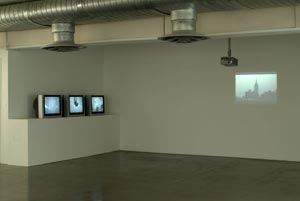GlassTire Video Interview 3: David McGee
{movremote}https://glasstire.com/images/stories/videos/mcgee.mov{/movremote}
For Houston artist David McGee, 2005 is by all accounts a banner time. From an ambitious curatorial project which appeared this Spring at The Menil Collection (Deep Wells and Reflecting Pools), to star turns in dual group shows at the Contemporary Arts Museum Houston (Perspectives @ 25, which unveiled October 2004, and Valerie Cassel Oliver’s well regarded DoubleConsciousness: Black Conceptual Art Since 1970), it’s been McGee’s turn to radiate. This fall, his longtime dealer Texas Gallery will showcase a 100-piece suite of recent watercolors focusing on the Japanese theater. As McGee revealed during our studio visit — providing us an advance peak — this series juxtaposes hip-hop figures with seemingly random text fragments to create an evocative intersection of poetry and painting, which in typical McGee fashion is informed by both Dada and Pop currents.
Indeed, McGee is a mid-career Texas art talent who’s been in the current limelight ever since his applauded solo show at DiverseWorks in December 2003, which saw the artist take over the main gallery with an installation entitled Telestai: Notebooks from the Black Sea. Loosely based upon a poem by Conrad Aiken, the complex work involved a massive, multi-panel narrative painting and sculpture cycle invoking pop culture, poetry, racial identity, art history and blues music. Telestaiwas to McGee what the 1964-1965 Pop masterwork F-111 was to James Rosenquist: extraordinarily effective as a potent calling card of the artist’s career and concerns.
2005 marks McGee’s 20th year as a professional artist on the Texas scene: He graduated fromPrairie View A&M in 1985 and his first one-person exhibition in Houston followed the next year. Since then, McGee has shown in numerous important group and solo exhibitions in Texas and beyond, at venues including Project Row Houses, the Glassell School of Art, the Blaffer Gallery, theGalveston Arts Center, Katonah Museum of Art, New York and Exit Art in Manhattan. His first museum solo show was at the Contemporary Arts Museum, Houston in 1998, a well-received exhibit entitled Black Comedies and Night Music. His 2000 solo at David Beitzel Gallery in SoHo, Black Flies and Socialites, was reviewed by ARTnews; the following year, he received a residency at RISD, which culminated in a 2001 solo there, which included a collaboration with Houston artist-designer Selven O’Keef Jarmon. To date, McGee’s work is represented in the permanent collections of the Museum of Fine Arts, Houston, Harvard University, the Rhode Island School of Design Museum, Texas Southern University, and the Addison Gallery of American Art, Andover, Mass.
Soon, McGee will embark on another challenging undertaking — scheduled for 2006-2007 — which involves an international collaboration culminating in four exhibitions at a quartet of contemporary art museums. Curated by the Contemporary Art Museum’s Lynn Herbert and Paola Morsiani, with a working title CAMH and RARE Art, the project sends McGee to New Zealand to consider the endangered environment. The other artists involved in the CAMH component are Canadian sound and video artist Janet Cardiff and LA-based painter Laura Owens.
For our interview, we caught up with McGee in his studio, sited in Houston’s rapidly gentrifying West End, to discover what informs his art practice. This artist is known first and foremost for his succulent way with paint. As he divulged, his canvases are largely about beauty. His simple statement, “I like to paint pictures,” is loaded with meaning as are his lusciously executed oils that recall 17th century Spanish masters in their fluid paint handling and dramatic passages of light and darkness. Utilizing recognizable subjects of people or items culled from contemporary culture — “Popular culture rules this world,” McGee told to GlassTire — combined with his adroit ability to put down almost abstract swaths of pigment on canvas, has allowed him brilliantly to sidestep the traditional art historical divide between abstraction and realism. Non-elitist, his richly layered work is not so much about a narrow reading of racial identity as the broader “aspects of what it is to be human,” informed by “tribal concerns” which have “very little to do with race.” Ultimately, for McGee, painting is about passion, and art making an absolute necessity for modern life: “Without art or creativity, this world is just a damned jungle.”

Catherine interviews David McGee!!… (7.5 MB download – please be patient.)… You need 11_Image_fp.jpg


